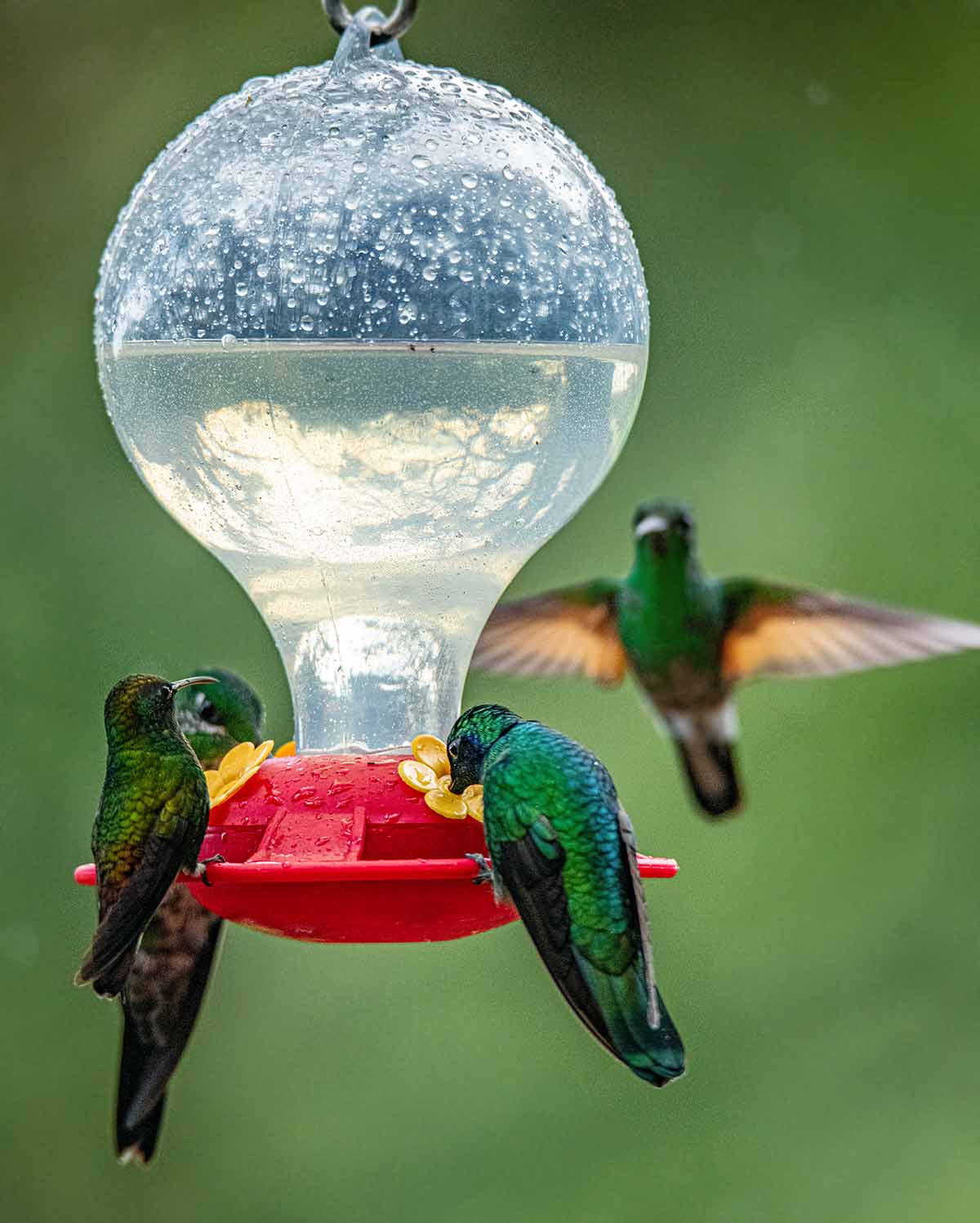
Jump To
- What are the benefits of making homemade hummingbird nectar?
- What’s the recipe for hummingbird nectar?
- What about using other types of sugar or sweeteners?
- Is red dye harmful to hummingbirds?
- How long will hummingbird nectar last?
- How to stop hummingbirds from fighting over the feeder
- How to help hummingbirds get ready for migration to warmer weather in the autumn
- How can I commune with my hummingbirds?
If you’ve visited Leite’s Culinaria even a few times, chances are you’ve discovered I’m known as Fatty Daddy. It’s a nickname I carry with pride–not so much as a nod to my porkly padding but rather for the affection with which it’s uttered by my worshipful staff. [Editor’s Note: Huh?!]
What you most likely don’t know is that for a tiny flock of folks, I’m known simply as Sugar Daddy.
Like all sugar daddies worth their bankrolls, I adhere to a clear-cut arrangement: I willingly pay for homes, take care of bills, and finance endless meals. In exchange, my little chickies are required to delight me, thrill me, charm me.
Lest you think you need to run to The One and warn him that I’ve practically set up a brothel of illicit doings, I’m talking about being a literal sugar daddy—to a squadron of hummingbirds.
For eight summers, our yard has swarmed with daredevil hummingbirds. We affectionately call them “humbees.” They feast on anywhere from one to several feeders, depending on the number of birds in the charm—charm is hummingbird speak for “flock.” And during that time, I’ve learned a lot about feeding, enjoying, and caring for these magnificent tiny flying machines.
What are the benefits of making homemade hummingbird nectar?
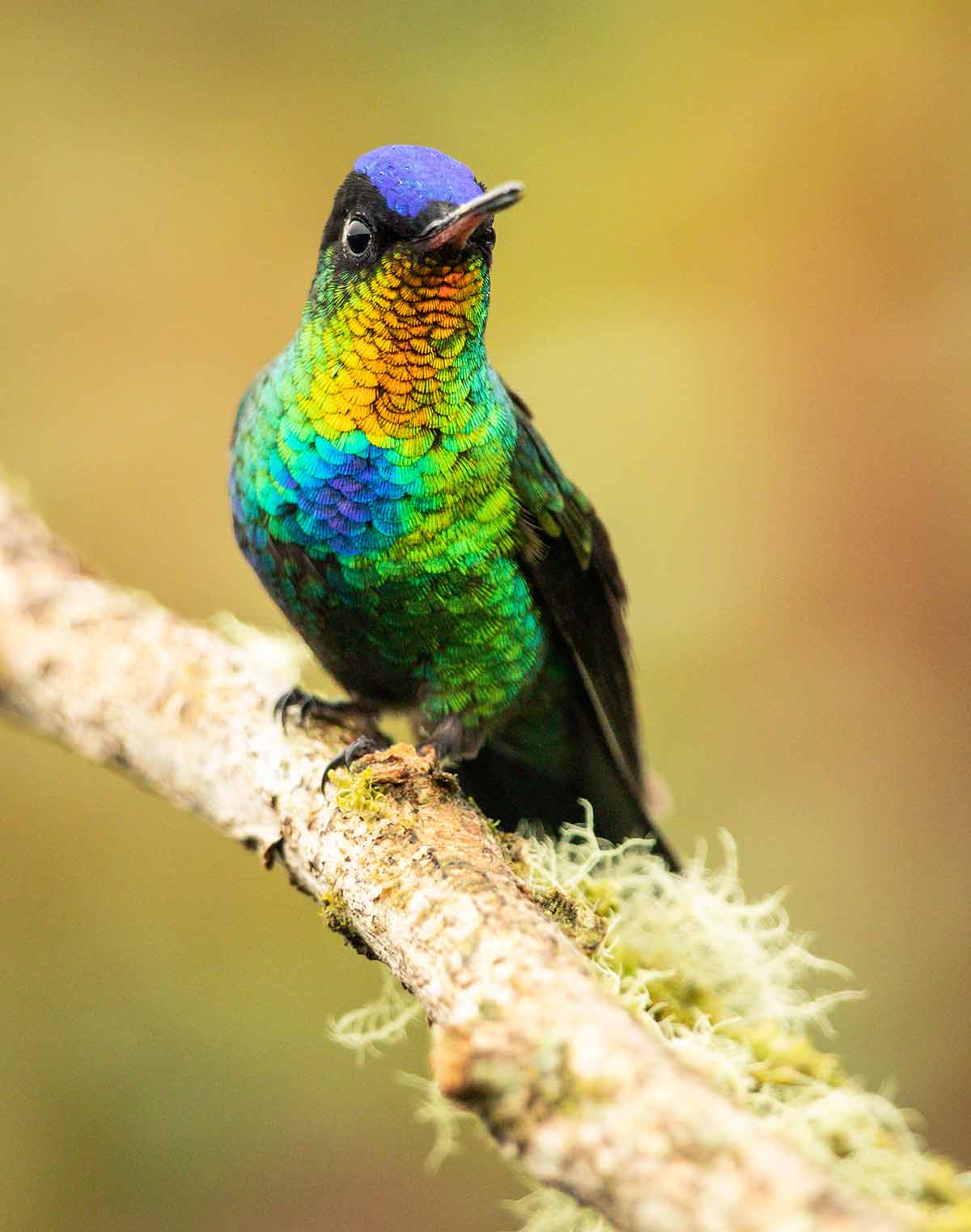
What aren’t the benefits is a better question. Homemade nectar is easy to make. It’s cheap–like 50 cents for a big-ass feeder’s worth. It’s fun and educational for the kids. And it makes you feel connected to nature. (Ok, I’m getting all woo-woo here, but it’s true for me. I feel like I’m giving back to ole Mama Nature and not always taking.)
What’s the recipe for hummingbird nectar?
It couldn’t be simpler.
4 cups water (if your tap water is hard, consider spring water)
1 cup granulated white sugar
- In a medium pot, bring the water to a boil over high heat.
- Remove the pot and pour in the sugar, stir until it dissolves, and then let the nectar cool completely.
- Fill the feeder.
- Marvel.
What about using other types of sugar or sweeteners?
Short answer: No.
Long answer: Nooooooooo!
You might think you’re being helpful by using organic, natural, or raw sugar, but they all contain varying amounts of impurities, such as iron, that can be harmful. Honey can promote a potentially deadly fungal growth. Brown sugar contains molasses–a big no for the kids–and confectioners sugar contains cornstarch. Stick to the white stuff.
Is red dye harmful to hummingbirds?

It’s an indubitable truth that hummingbirds are attracted to the color red. Why? Because in nature, red often signifies a high-energy food source. (Think of it as avian Red Bull.) That’s why hummingbird feeders are ruby red. And so, too, are commercial liquid and powdered nectar.
Is red dye harmful to birds? Is it toxic? Will it kill them? Back in the day, red dye was toxic to humans, and it was thought to be the same for animals. Today, red dye is supposedly safe for humans. But is it safe for hummingbirds? Some hummer experts have witnessed a higher rate of death and tumors in birds that sipped red nectar. Sorry, but my flying jewels aren’t becoming statistics. For me, it’s just sugar, water, and a whole lotta love.
If you feel the need to pimp your feeder, do as I did. I took an old, faded feeder and festooned it with plenty of red ribbons. The hummingbirds found it irresistible. (Why I have rolls of sparkly red ribbon on hand is none of your business, thank you very much.)
How long will hummingbird nectar last?
About a week in the fridge. I used to make a half-gallon of nectar at a time and store it in the fridge in quart-size glass bottles with rubber stoppers. That would last me eight days when we had our biggest charm of birds. Alas, most of my babies didn’t return this year. (I try not to take it personally, and sometimes fantasize they, too, are in pandemic lockdown mode somewhere in Boca Raton, concerned about giving their fat old Sugar Daddy any nasty virus.) This summer, I’ve been making a small batch every two or three days, which is the longest you want the nectar to sit in the feeder, otherwise it will start to ferment.
How to stop hummingbirds from fighting over the feeder
I’ve watched, with unvarnished envy, videos of huge charms of hummingbirds in a feeding frenzy at their round red snack bars. I mean dozens of birds sharing the buffet–graciously swapping seats and giving up their perches, making sure everyone has enough to eat. At our house, especially in years past, these suckers dive-bombed and aggressively chased each other off in the name of protecting a motherlode of nectar so large that could feed the entire feathered population of Rhode Island. (Cue the soundtrack to “The Birds.”) It seemed no one but the mightiest ever sipped. To remedy that, I hung feeders all over the yard, making it impossible to commandeer more than one at a time. Costly? A bit. But at least I got humbee action from every window of the house.
How to help hummingbirds get ready for migration to warmer weather in the autumn
Nectar is energy. And energy feeds humbees’ tiny wings and hearts, which can beat up to 4,800 and 1,300 times per minute, respectively. Toward the end of the season (for us in Connecticut that’s mid-September), I change their nectar ratio from 4:1 to 3:1. It gives the hummingbirds an extra boost of energy for the long haul south.
How can I commune with my hummingbirds?
As flitty as they are, hummingbirds are pretty social creatures. A few summers ago, I got some real Barbara Walters up-close-and-personal time with them. I took one of our flying-saucer feeders off the window and held it out in front of me. A few minutes later, one of the more adventurous males swooped by, hovered inches from my face (so close I could feel the breeze from his wings), then darted away. In no time, he and a bunch of his iridescent brethren were noshing at the feeder. I stood in amazement as they relaxed enough to sit on their perches, oblivious of me. Alas, I fear it was hunger rather than my Buddha-like spirit that attracted them. [Editor’s Note: David asked us to alert you that it’s not him in the video. You would know if it was David by his flair for drama even when standing still.]
Perhaps my greatest joy was the time I positioned my hand so that it covered most of the perch. One brave little Calliope hummingbird alighted on my finger and settled in for a long sip.
It doesn’t get much better than that.
xo,
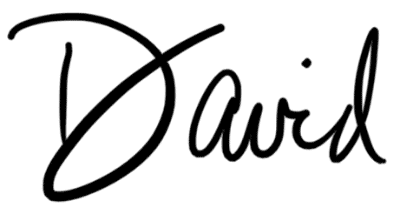
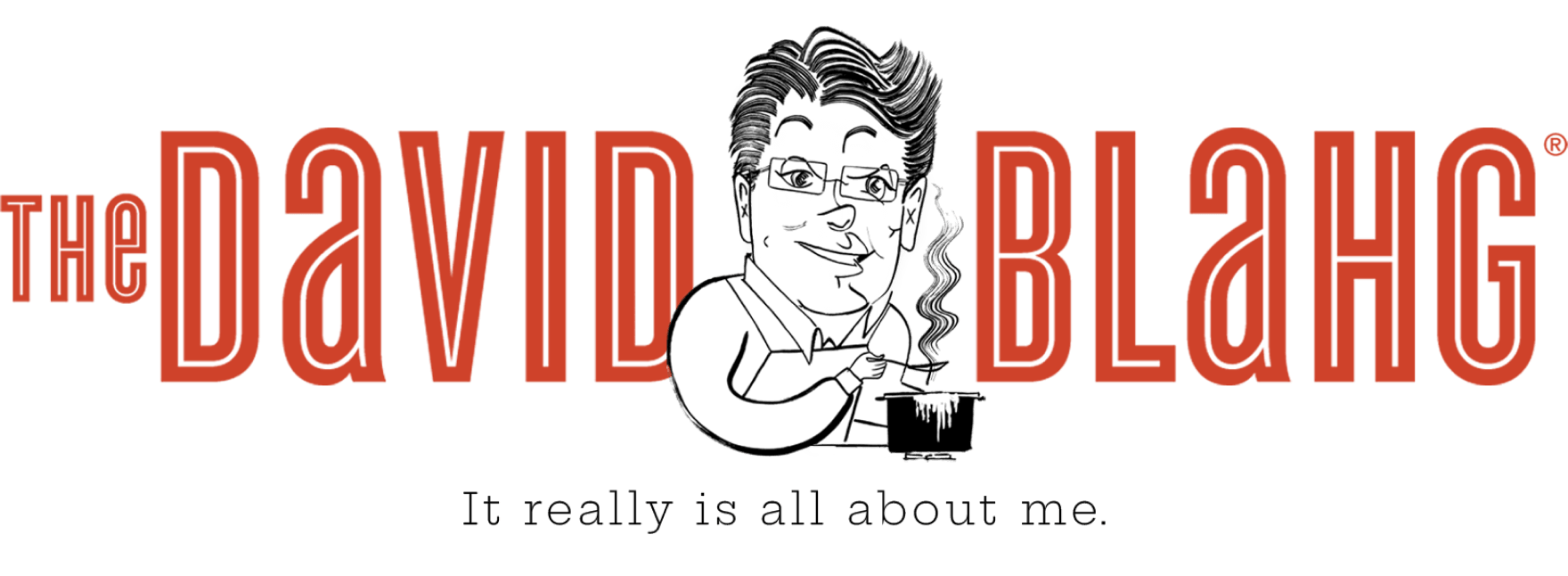
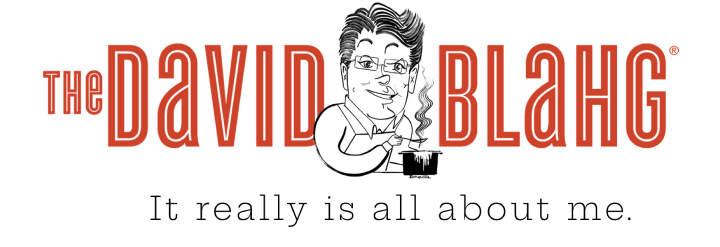
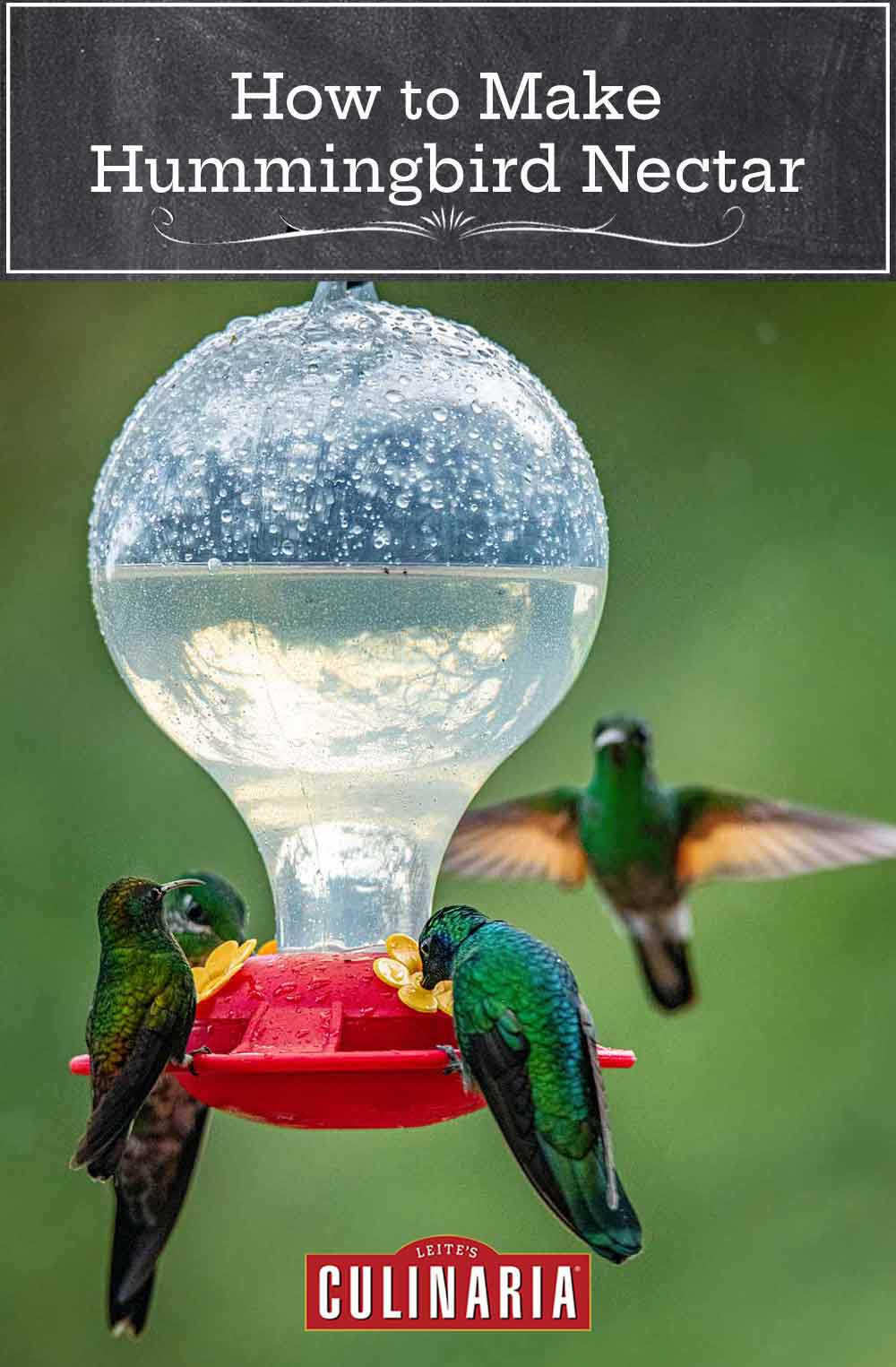










Thanks for the article.
Wasps are an issue. What is a good, natural remedy?
Amy,
How do you keep the ants away from the feeder?
Lisa, we had a big ant problem with feeders that were attached to the house or windows (with suction cups). But since we have been hanging the feeder on a pole, there’s not an ant in sight. Where is your feeder?
Please please do not use an open container to hand-feed hummingbirds. If sugar water happens to get on their feathers, their feathers will fall out and they will die a slow and painful death due to hypothermia and starvation. This link is from a licensed hummingbird and bird rehabber in Virginia.
One last thing: When making nectar, be sure you’re boiling Unmeasured water FIRST, for only 2 to 3 minutes. Then measure out your 4 parts water, then add your measured 1 part sugar. Let cool to room temp, then fill a clean feeder. Be sure you’re cleaning feeders with dawn dish soap (licensed hummingbird and songbird rehabber Susie Niwa suggests it). It’s what wildlife officials, rescuers, and rehabbers use. Just wash them the way you hand wash dishes. Be sure to use a bottle brush and port brushes, which can be purchased online or at Wild Birds Unlimited. You can also use a lash and brow wand sold at Walmart. They’re awesome. I use them all. Mold kills and if the water is cloudy or has white stringy stuff in it, it’s already fermented and will cause sickness and death to these tiny little gems!
Again, thanks, HW!
Hummingbird Warrior, I wasn’t aware of that, thank you. I’d never want to do anything to jeopardize my humbees. I did hold the feeder itself, so there was no problem. I replace the previous video with one of person holding a mini feeder.
I have two hummimgbird feeders hanging off our very old apple tree, where they have nested. Usually there are three – four competitive hummers going after it – I believe it’s the mother and young ones now – but they still try to run each other off. I added an oriole feeder on a pole nearby because some Baltimore Orioles and their young are crazy about the nectar feeders so I wanted to provide more options. That seems to work so far, although the orioles still go after the hummingbird feeder.
Susan, I think variety and distance are good solutions. I still don’t see how folks have a “feeder farm”–half a dozen, or more, feeders together without an issue. It just dawned on me: Perhaps there’s so much food that everyone is satisfied!
We have had ants travel up our shepherd’s hook. So I wrapped a cloth shoe string around the base of the pole and soaked it with a bug spray. It lasts quite a long time and is a safe distance from the birds.
Penny, interesting solution.
Ant Moat. When deterring ants, always make sure to purchase Ant Moats instead of Ant Guards. Ant Guards contain pesticides that could be quite harmful to hummingbirds. One of the pesticides, Zeta-cypermethrin, for example, is highly toxic to cats and causes rats to be born with developmental delays. It has not been tested on any type of bird, much less hummingbirds. Hummingbirds are curious creatures known to probe small spaces near feeders with their bills and tongues looking for nectar sources. The slight opening at the bottom of an Ant Guard gives access to the pesticides to the birds. We never recommend using any type of pesticide around a hummingbird feeder.
Ant Moats filled with water are the only safe, easy, tried and true way to deter ants. You can purchase them or DIY at home. Just do it! Hang your feeder from an Ant Moat, fill with water. It couldn’t be any easier. Happy, healthy hummingbirds, an ant-free feeder, and no potential exposure to poisons! You might even get a bird or 2 drink the water from the ant moat.
This is an ant moat. Easy to make and safe for hummingbirds. Just fill 1/2 to 3/4 of the way up with plain water. Since ants can’t swim, they can’t get to your feeder. I have ants in my yard but never had have 1 ant on any of my 22 feeders.
The Ant Moat is a reliable first line of defense against ants attempting to infiltrate hummingbird feeders. When filled with water, the Ant Moat forms a barrier that keeps ants away from the irresistible nectar of the hummingbird feeders. The ant moat goes in between the shepherd rod and feeder.
Here is a video I made a few years ago. You can use a spray paint can lid that is not pre-holed, detergent lid, shaving cream lid not pre-holed, etc. Simple and easy to make.
Thanks for this, Hummingbird Warrior.
Ooohhh! I have one of those on the top of my Perky Pet feeder, and I thought it was a little water dish… the chickadees love it!
Hi David. Really enjoyed reading this! Isn’t nature wonderful? I’ve been watching all the activities in my own backyard while working from home this summer. I had a dedicated dad sparrow who brought his three girls to my herb & vegetable garden everyday. The little ones could play hidden under the tarragon and lettuces, splash in the birdbath, and practice catching moths midair. I also observed caterpillars on my parsley become black swallowtail butterflies. Such a respite.
Chiyo, such a respite, indeed. Especially at this time. And I just discovered we have two more hummingbirds. I guess they read the post!